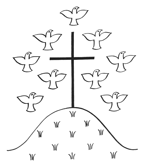
Part Three: The Will of God
The Ten Commandments
 The Ten Commandments are also called the Decalogue, from the
Greek deka, ten, and logos, word. They are therefore the Ten Words of
God which synthesize God’s covenant with His chosen people.
The Ten Commandments are also called the Decalogue, from the
Greek deka, ten, and logos, word. They are therefore the Ten Words of
God which synthesize God’s covenant with His chosen people.
They were divinely revealed to Moses on Mount Sinai and engraved on two tablets of stone. Moses broke the stone tablets in anger when he came down from the mountain and saw the people practicing idolatry. However, the tablets were later replaced and placed in the Ark of the Covenant. There are two versions of the Ten Commandments, in Exodus 20:1-17 and Deuteronomy 5:6-18. Although very similar, they differ in various ways. In Exodus, for example, the observance of the Sabbath is based on a religious motive, namely weekly to commemorate Yahweh’s resting on the seventh day after creating the world. In Deuteronomy, the Sabbath is a day of rest from labor, where the motive is more humanitarian. The two versions also differ on the prohibition of covetousness. In Exodus, a man’s wife is classified along with his other possessions that others may not covet. In Deuteronomy, the wife is classified separately. Christ did not suppress the Ten Commandments. He not only kept them as found in His Sermon on the Mount, but He deepened and elevated them far beyond what had been prescribed in the Old Law. From the earliest days of the Church, the Ten Commandments held a central place in Christian instruction. According to St. Thomas Aquinas and St. Bonaventure, the Ten Commandments are really the Natural Law. The precepts of the Decalogue can be known by the light of reason without revelation. But God revealed them through Moses to the human race in order that everyone would know what the Creator requires of His creatures as a condition for attaining eternal life. There is some difference in the numbering of the Ten Commandments. In the Greek, Anglican, and Protestant churches – excluding the Lutheran – the prohibition of false worship becomes two commandments; there is a separate commandment about “graven images.” Then in order to keep the number ten, the precept against covetousness is combined with the prohibition of lustful desires. In the Catholic Church, there is only one commandment against false worship. But there are two separate precepts against internal sins of lust and greed, as the ninth and tenth commandments. They correspond to the sixth and seventh precepts which forbid adultery and stealing. In our treatment of the Ten Commandments, we shall consider each precept in two stages. First we will see what the commandment prescribes, not only in the Old Testament but also in our day. Then we will look more closely to find out how Christ elevated each precept and has guided His Church to teach the obligations of Christianity. There is great practical value in examining the Decalogue in this way. For centuries now, the Church has had to insist on three doctrines that form the bedrock of Christian morality. They were defined in the sixteenth century.
To be emphasized is that Christ is the Living God who became man to save us by teaching what we must do to reach heaven, and by providing the necessary grace “to observe all the commandments I gave you” (Matthew 28:20).  Copyright © 2002 Inter Mirifica
Pocket Catholic Catechism |